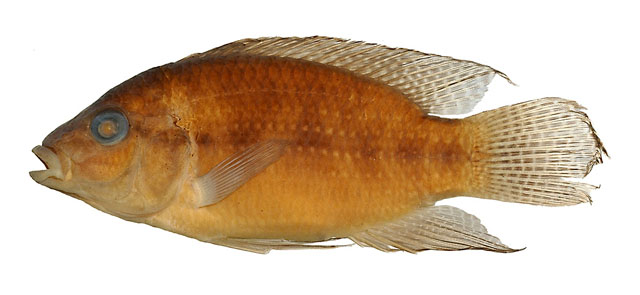| Cichlidae (Cichlids), subfamily: Pseudocrenilabrinae |
| 9.12 cm SL (male/unsexed) |
|
demersal; freshwater |
| Africa: known only from the Ivindo River system in the regions of Makokou and Belinga, central Gabon (Ref. 50579, 81260). |
|
Dorsal spines (total): 15-15; Dorsal soft rays (total): 11-11; Anal spines: 3-3; Anal soft rays: 7-8; Vertebrae: 25-25. Diagnosis: lachrymal plus four tubular infraorbitals; slight gap between third and fourth tubular infraorbital; snout acutely pointed; soft dorsal and anal fins, and caudal fin maculae often present but not usually forming distinct vertical bands on caudal fin; body depth 35.4-42.1% SL; caudal peduncle length 57.7-86.5% of width; anterior pelvic rays of mature females not black-tipped (Ref. 81260).
Description: robust, deep-bodied (body depth 35.4-42.1% SL); head length 33.0-37.2% SL; snout short, relatively acute; predorsal profile rises steeply over eyes, smoothly convex to dorsal origin; mouth moderately small; lower jaw inclined slightly upward; ventral body wall rounded to caudal peduncle, which is short and deep; upper branch of lateral line lower on body than in congeners and separated from dorsal base at highest point by 2-2.5 scale rows; 11-12 tuberculate rakers on lower limb of first arch, four lanceolate epibranchial rakers; first ray of pelvic fin longest in both sexes, and produced in males; caudal fin rounded in both sexes, upper lobe never produced or elongated in males; males usually larger than females (Ref. 81260).
Coloration: preserved specimens more or less uniformly brown, with cheeks, opercle and chest paler than rest of body; in larger specimens flank scales are marked with a central spot, which is probably iridescent in life; unpaired fins with many rows of dark maculae (Ref. 81260). |
| Collected in small forest creeks and streams (Ref. 50579). Pair-bonding (Ref. 52307), monogamous, biparental, substrate spawner displaying some degree of sexual dichromatism (Ref. 81260). Cave spawner (Ref. 52307). |
|
Endangered (EN); Date assessed: 16 February 2009 (B1ab(iii)+2ab(iii)) Ref. (130435)
|
| harmless |
Source and more info: www.fishbase.org. For personal, classroom, and other internal use only. Not for publication.
